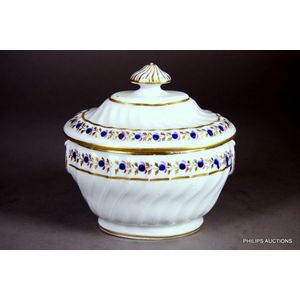Neoclassical Coalport Sucrier with John Rose Knop and Handles
You must be a subscriber, and be logged in to view price and dealer details.
Subscribe Now to view actual auction price for this item
When you subscribe, you have the option of setting the currency in which to display prices to $Au, $US, $NZ or Stg.
- Chevron Motif - In jewellery, a chevron is a V-shaped pattern or design that is often used to create a bold and striking visual effect, and as a symbol of strength, power and protection.. It is a classic motif used in many different styles of jewellery and can be seen in various forms such as on a ring, earrings, bracelets, and necklaces. It can be created with precious or semi-precious stones, pearls, or enamel. It can be found in different forms such as engraved or inlaid or beaded.
In ceramics the pattern is often used in decorative pottery and porcelain pieces, such as vases, bowls, plates and figurines. The chevron pattern can be created by using different colored glazes or by hand-painting the design onto the piece. It is also commonly found in the form of embossing or intaglio in decorative ceramic objects. This pattern can be seen as a popular design choice in Art Deco and Art Nouveau style of ceramics.
This chevron pattern can also be found in many different types of furniture, such as tables, chairs, chests of drawers, and cabinets. A common place to find chevron pattern is in a herringbone pattern, which is made up of repeating V-shaped patterns. The chevron pattern can be created by using different types of wood, inlaying or by using different colors of stain. It is also commonly found in the form of a veneer. This pattern can be seen as a popular design choice in mid-century modern, Art Deco, and contemporary style furniture. - Circa - A Latin term meaning 'about', often used in the antique trade to give an approximate date for the piece, usually considered to be five years on either side of the circa year. Thus, circa 1900 means the piece was made about 1900, probably between 1895 and 1905. The expression is sometimes abbreviated to c.1900.
- Knop (ceramics) - In ceramics, a knop is a protuberance on the top of an object, and can be either decorative, or used as a knob to lift the item.
- Laurel Leaf - The use of the laurel leaf as a decorative element can be traced back to ancient Greece and Rome, where it was closely associated with victory and honour. In these cultures, the laurel was a sacred tree that was dedicated to the god Apollo and was believed to have protective and healing properties.
In ancient Greece, the laurel wreath was awarded to victors in athletic competitions, such as the Olympic Games, as a symbol of their achievement. The wreath was also associated with academic achievement, and was often worn by scholars and poets. The Greeks also used the laurel leaf as a symbol of victory in war, and it was often depicted in artwork alongside images of triumphant warriors and heroes.
The Romans continued this tradition, and the laurel wreath became a symbol of the highest military honor, the triumph, awarded to victorious generals. The wreath was also used to crown emperors and other important officials, and was often depicted in Roman art and architecture as a symbol of power and authority.
The laurel leaf is still used as a symbol of achievement, success, and excellence, and is frequently used in logos, emblems, and other branding materials. Its association with victory and honour has made it a popular choice for awards, medals, and other forms of recognition. - Frieze - An architectural term denoting the flat, shaped or convex horizontal surface of furniture, between the architrave and the cornice, usually found on a cabinet or bookcase, or on desks and tables where it may include drawers, the area between the top and the legs. In ceramics, the term refers to the banding, of usually a repeating pattern, on the rims of plates and vases.
This item has been included into following indexes:
Visually similar items

A Chamberlain's Worcester covered sucrier, circa 1795-1,800, of shanked or fluted decor, the oval sucrier with a shaped domed lid and finial, with decorative integral ring handles to the ends, decorated with blue and puce floral borders with gilt enrichmen

A Chamberlain's Worcester sugar box, circa 1797, pattern 55, the shanked oval box with ring handles and a domed lid with finial, decorated with a navette border and pendant foliage, the lid marked Chamberlain's Worcester Warranted, height 14 cm, length 14.

A Minton Japan pattern sugar box, circa 1810, pattern 558, a boat shaped sugar box with a domed lid and finial featuring trees and a lattice bridge in iron red, cobalt, orange and green colours with gilt enrichments upon a white ground, pattern number unde

Early 19th century Chamberlain Worcester sucrier and cover
